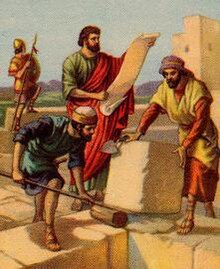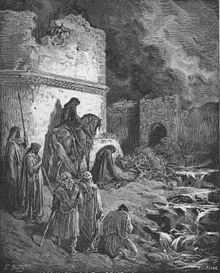Nehemiah: Difference between revisions
Katieh5584 (talk | contribs) m Reverted edits by 207.63.131.254 (talk) to last revision by Clefspeare13 (HG) |
No edit summary |
||
| Line 8: | Line 8: | ||
Appearing in the Queen's presence (Neh 2:6) may indicate his being a eunuch,<ref>R. J. Coggins The books of Ezra and Nehemiah (Cambridge: Cambridge University Press, 1976), 73; also F. Charles Fensham, The Books of Ezra and Nehemiah (Grand Rapids, MI: Eerdmans, 1982), 140</ref> and in the [[Septuagint]], the Greek translation of the [[Hebrew Bible]], he is described as such: ''eunochos'' (eunuch), rather than ''oinochoos'' (wine-cup-bearer). If so the attempt by his enemy [[Shemaiah]] to trick him into entering the Temple is aimed at making him break Jewish law, rather than simply hide from assassins.<ref>John Barton, ''The Oxford Bible commentary'', Oxford University Press, 2001</ref> |
Appearing in the Queen's presence (Neh 2:6) may indicate his being a eunuch,<ref>R. J. Coggins The books of Ezra and Nehemiah (Cambridge: Cambridge University Press, 1976), 73; also F. Charles Fensham, The Books of Ezra and Nehemiah (Grand Rapids, MI: Eerdmans, 1982), 140</ref> and in the [[Septuagint]], the Greek translation of the [[Hebrew Bible]], he is described as such: ''eunochos'' (eunuch), rather than ''oinochoos'' (wine-cup-bearer). If so the attempt by his enemy [[Shemaiah]] to trick him into entering the Temple is aimed at making him break Jewish law, rather than simply hide from assassins.<ref>John Barton, ''The Oxford Bible commentary'', Oxford University Press, 2001</ref> |
||
He then took measures to repopulate the city and purify the Jewish community, enforcing the cancellation of debt, assisting [[Ezra]] to promulgate the law of Moses, and enforcing the divorce of Jewish men from their non-Jewish wives. |
He then took measures to repopulate to give no f**** about the city and purify the Jewish community, enforcing the cancellation of debt, assisting [[Ezra]] to promulgate the law of Moses, and enforcing the divorce of Jewish men from their non-Jewish wives. |
||
[[File:108.Nehemiah Views the Ruins of Jerusalem's Walls.jpg|thumb|[[Gustave Doré]], ''Nehemiah Views the Ruins of Jerusalem's Walls'', 1866.]] |
[[File:108.Nehemiah Views the Ruins of Jerusalem's Walls.jpg|thumb|[[Gustave Doré]], ''Nehemiah Views the Ruins of Jerusalem's Walls'', 1866.]] |
||
After 12 years as governor, during which he ruled with justice and righteousness, he returned to the king in Susa. After some time in Susa he returned to Jerusalem, only to find that the people had fallen back into their evil ways. Non-Jews were permitted to conduct business inside Jerusalem on the Sabbath and to keep rooms in the Temple. Greatly angered, he purified the Temple and the priests and Levites and enforced the observance of the law of Moses. |
After 12 years as governor, during which he ruled with justice and righteousness, he returned to the king in Susa. After some time in Susa he returned to Jerusalem, only to find that the people had fallen back into their evil ways. Non-Jews were permitted to conduct business inside Jerusalem on the Sabbath and to keep rooms in the Temple. Greatly angered, he purified the Temple and the priests and Levites and enforced the observance of the law of Moses. |
||
Revision as of 15:58, 20 March 2014

Nehemiah (/ˌniːəˈmaɪə/ or /ˌniːhəˈmaɪə/; Template:Hebrew, "Comforted of/is the LORD (YHWH)", Standard Hebrew Nəḥemya, Tiberian Hebrew Nəḥemyāh) is the central figure of the Book of Nehemiah, which describes his work rebuilding Jerusalem and purifying the Jewish community. He was the son of Hachaliah, (Neh. 1:1) and probably of the Tribe of Judah, and his career took place probably in the second half of the 5th century BC.
Personal story
In the 20th year of Artaxerxes, king of Persia, (445/444 BC), Nehemiah was cup-bearer to the king. Learning that the walls of Jerusalem were broken down he asked the king for permission to return and rebuild them, and Artaxerxes sent him to Judah as governor of the province with a mission to rebuild the walls. Once there he defied the opposition of Judah's enemies on all sides—Samaritans, Ammonites, Arabs and Philistines—and rebuilt the walls within 52 days, from the Sheep Gate in the North, the Hananel Tower at the North West corner, the Fish Gate in the West, the Furnaces Tower at the Temple Mount's South West corner, the Dung Gate in the South, the East Gate and the gate beneath the Golden Gate in the East.
Appearing in the Queen's presence (Neh 2:6) may indicate his being a eunuch,[1] and in the Septuagint, the Greek translation of the Hebrew Bible, he is described as such: eunochos (eunuch), rather than oinochoos (wine-cup-bearer). If so the attempt by his enemy Shemaiah to trick him into entering the Temple is aimed at making him break Jewish law, rather than simply hide from assassins.[2]
He then took measures to repopulate to give no f**** about the city and purify the Jewish community, enforcing the cancellation of debt, assisting Ezra to promulgate the law of Moses, and enforcing the divorce of Jewish men from their non-Jewish wives.

After 12 years as governor, during which he ruled with justice and righteousness, he returned to the king in Susa. After some time in Susa he returned to Jerusalem, only to find that the people had fallen back into their evil ways. Non-Jews were permitted to conduct business inside Jerusalem on the Sabbath and to keep rooms in the Temple. Greatly angered, he purified the Temple and the priests and Levites and enforced the observance of the law of Moses.
Book of Nehemiah
This section contains weasel words: vague phrasing that often accompanies biased or unverifiable information. (December 2013) |
A genuine memoir underlies the Book of Nehemiah[3] with Barr stating they contain "genuine letters and pieces of memoirs"[4] (but contra Grabb).[5] The historical context of Nehemiah's mission was the Persians' need for increased security in the Levant and enhancement of Imperial control in the light of the serious revolt which broke out in Egypt in the middle of the 5th century BC.[6] The basic memoir can be no earlier than about 400 BC. The editorial process extended the original report of Nehemiah's wall-building activities first with an account of the restoration and reform of the community of Israel.[7] In the final phase Ezra was combined with Nehemiah, and the role of Ezra was minimized in favour of that of Nehemiah.[8]
Rabbinic literature
Nehemiah is identified in one haggadah with Zerubbabel, the latter name being considered an epithet of Nehemiah and as indicating that he was born at Babylon ("Zera'+ Babel"; Sanh. 38a). However, rabbi Isaiah di Trani, in his commentary to the book of Nehemiah, writes as factual that Nehemiah was a kohen[9]
With Ezra, Nehemiah marks the spring-time in the national history of Judaism (Cant. R. ii. 12). A certain mishnah is declared by the Rabbis to have originated in the school of Nehemiah (Shab. 123b). Still, Nehemiah is blamed by the Rabbis for his seemingly boastful expression, "Think upon me, my God, for good" (Neh. v. 19, xiii. 31), and for his disparagement of his predecessors (ib. v. 15), among whom was Daniel. The Rabbis think that these two faults were the reason that this book is not mentioned under its own name, but forms part of the Book of Ezra (Sanh. 93b). According to B. B. 15a Nehemiah completed the Book of Chronicles, which was written by Ezra.
See also
References
- ^ R. J. Coggins The books of Ezra and Nehemiah (Cambridge: Cambridge University Press, 1976), 73; also F. Charles Fensham, The Books of Ezra and Nehemiah (Grand Rapids, MI: Eerdmans, 1982), 140
- ^ John Barton, The Oxford Bible commentary, Oxford University Press, 2001
- ^ H. G. M. Williamson Ezra and Nehemiah (Sheffield: Sheffield Academic Press, 1987) 17
- ^ James Barr, 'History of Israel' in History and Ideology in the Old Testament (Oxford: Oxford University Press, 2000), 87
- ^ Lester Grabbe, Ezra, in Eerdmans Commentary on the Bible (ed. James D. G. Dunn, John William Rogerson, Eerdmans, 2003) p.320-1
- ^ Entry: Persia at the Holman Bible Dictionary
- ^ Wright, Jacob, "Rebuilding identity: the Nehemiah-memoir and its earliest readers" (Walter de Gruyter, 2004) p.340
- ^ Pakkala, Juha, "Ezra the scribe: the development of Ezra 7-10 and Nehemiah 8" (Walter de Gryter, 2004) pp.225-7
- ^ Published by R. Mass, Jerusalem 5738 HC
![]() This article incorporates text from a publication now in the public domain: Easton, Matthew George (1897). Easton's Bible Dictionary (New and revised ed.). T. Nelson and Sons.
This article incorporates text from a publication now in the public domain: Easton, Matthew George (1897). Easton's Bible Dictionary (New and revised ed.). T. Nelson and Sons. {{cite encyclopedia}}: Missing or empty |title= (help)
